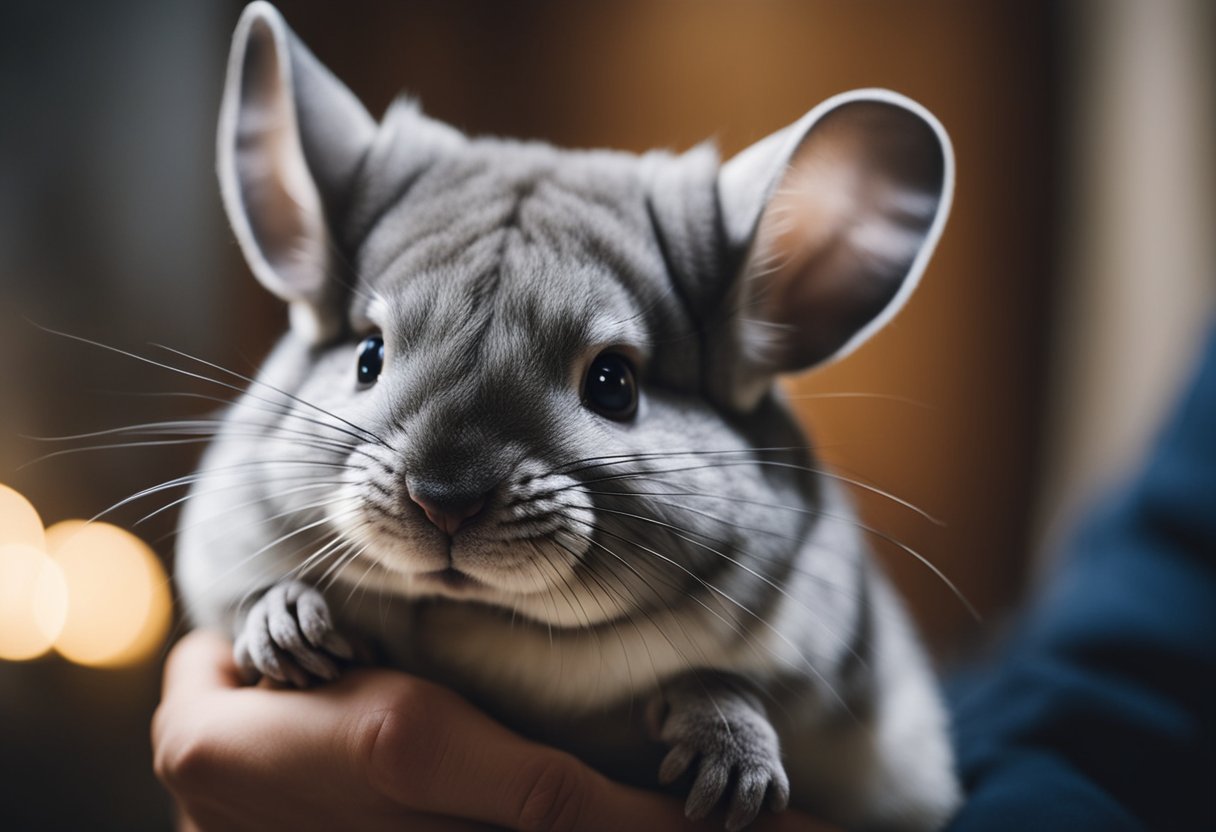Handling a chinchilla can be a rewarding experience, but it requires some understanding of their unique needs and behaviors. To successfully handle a chinchilla, approach them gently and support their body while making sure they feel safe. With patience and the right techniques, you can build a trusting relationship with your pet.

Before you reach for your chinchilla, it’s important to learn about their preferences and stress signals. These small animals can be skittish, so using a calming approach is essential. This blog post will guide you through safe handling methods to ensure both you and your chinchilla feel comfortable during the process.
Whether you’re a new chinchilla owner or looking to improve your handling skills, knowing how to properly interact with your pet will make a big difference. Understanding their needs helps create a friendly bond that benefits both you and your furry companion.
Key Takeaways
- Handle your chinchilla gently to help them feel secure.
- Learn to recognize signs of stress in chinchillas.
- Building trust is key to a positive relationship with your pet.
Understanding Chinchilla Basics

To care for a chinchilla, it is important to know their natural habitat, physical traits, and dietary requirements. Understanding these basics will help you create a suitable environment for your chinchilla and meet its needs.
Natural Habitat and Behavior
Chinchillas are native to the Andes Mountains in South America. They live in rocky areas where they can easily hide from predators. In the wild, they are nocturnal, meaning they are active at night and sleep during the day.
These small animals are social creatures. They prefer to live in groups and can exhibit playful behavior when comfortable. Chinchillas communicate through a series of sounds, including barks and squeaks, which express their needs and moods.
Understanding their natural habitat helps you replicate an environment that feels safe and comfortable for your pet. Provide multiple levels in their cage and hiding spots to mimic their need for exploration and security.
Physical Characteristics
Chinchillas have distinct physical traits that make them unique. They are small, typically weighing between 1 to 2 pounds. Their fur is dense and soft, providing insulation in their cold native climate.
A chinchilla’s large ears help with hearing and temperature regulation. They can also have long whiskers that are used for sensing their surroundings. Their hind legs are powerful, allowing for impressive jumps and agile movements.
Keeping these characteristics in mind can help you provide appropriate care. Ensure their living space is safe and offers opportunities for them to climb and jump without injury.
Dietary Needs
A proper diet is crucial for your chinchilla’s health. The main component of their diet should be high-quality hay, like timothy or orchard grass. This provides essential fiber, which is important for digestion.
Chinchillas also benefit from a small amount of specially formulated pellets. These pellets should not exceed 1-2 tablespoons per day to avoid obesity. Treats, such as small pieces of dried fruit or chew sticks, can be given sparingly.
Always ensure fresh, clean water is available. Monitoring your chinchilla’s diet can prevent health issues and promote a long, healthy life.
Caring for Your Chinchilla

Caring for your chinchilla involves creating a safe living space, learning proper handling techniques, monitoring health, and meeting their social needs. Each aspect is important to ensure your pet thrives and remains happy.
Creating a Safe Environment
Start by setting up a secure habitat for your chinchilla. Choose a spacious cage that allows for jumping and climbing. The cage should be at least 24 inches wide, 24 inches deep, and 36 inches tall.
Make sure the cage has solid shelves and appropriate bedding. Avoid cedar or pine shavings, as these can harm their respiratory system. Instead, use paper-based bedding or aspen shavings.
Keep the cage in a cool room, ideally between 50-70°F. Avoid direct sunlight or drafts. Regularly clean the cage to prevent germs and bacteria from building up.
Handling Techniques
When you’re ready to handle your chinchilla, be calm and gentle. Always approach them slowly to avoid startling them.
Support their body with both hands, and don’t grab their tails, as it may injure them. You want to make them feel secure. Let them hop onto your hand if they prefer.
Practice short handling sessions at first. Gradually increase the time as your chinchilla becomes more comfortable. Always watch their body language. If they seem stressed, give them space.
Health Monitoring and Veterinary Care
Regular health check-ups are crucial for your chinchilla’s well-being. Look for signs of illness, such as changes in appetite, weight loss, or lethargy.
You should also check their teeth regularly. Overgrown teeth can cause serious health issues. Ensure they have plenty of chew toys made from safe materials.
Schedule a veterinary visit at least once a year. Find a vet experienced with small animals like chinchillas. They can offer vaccinations and help with any health concerns.
Interaction and Social Needs
Chinchillas are social creatures. They thrive on interaction with you and can benefit from companionship. Spend time daily playing or petting them.
Consider having more than one chinchilla for social bonding. If you do, make sure they are both of the same sex to prevent breeding.
Provide a variety of toys to keep them engaged. Rotate toys regularly to maintain their interest. Exercise time outside the cage is also essential, but ensure they are in a safe area where they can’t escape or get hurt.
Resources

When handling a chinchilla, it’s important to use reliable resources for the best practices. Here are some informative links to help you:
- Learn about the best techniques for holding a chinchilla. One method includes supporting the body while gently grasping the tail. Check it out here.
- Understand the importance of gentle handling. Chinchillas can be easily startled, so it’s best to approach them calmly. For tips on this, see this guide.
- To familiarize yourself with the first time you hold a chinchilla, there are steps that can ease the process. Read more about it here.
- Find out how to create a stress-free environment for your chinchilla. This includes avoiding sudden movements and loud noises. More details can be found here.
- For visual learners, consider resources that include pictures and step-by-step instructions on holding a chinchilla safely. An example can be found here.
These resources can guide you in properly handling your chinchilla and ensuring a positive experience for both you and your pet.
Frequently Asked Questions

Handling a chinchilla requires attention to safety, comfort, and proper techniques. Knowing the best practices can help you create a positive experience for both you and your pet.
What is the safest way to handle a chinchilla?
The safest way to handle a chinchilla is by using the tail and scoop method. Hold the base of the tail with one hand while supporting the body with the other. Make sure to lift gently and keep the chinchilla close to your chest to provide a sense of security.
How often should chinchillas be handled?
Chinchillas should be handled regularly, about 2-3 times a week. This helps them become accustomed to human interaction. Always keep sessions short, around 10-15 minutes, to prevent stress.
What are the do’s and don’ts when holding a chinchilla?
Do approach your chinchilla slowly and let them see your hand. Use both hands for support and keep a firm yet gentle grip. Don’t make sudden movements or loud noises, as this can frighten them. Avoid holding them too tightly, which can cause distress.
How can you tell if a chinchilla is comfortable with being held?
A comfortable chinchilla will relax in your hands and may even nuzzle against you. Look for calm body language, such as a relaxed tail and ears positioned forward. If your chinchilla tries to jump or squirms away, it may be feeling insecure.
What measures should be taken to prevent a chinchilla from biting?
To prevent a chinchilla from biting, always handle them gently and calmly. Avoid sudden movements and let them approach you first. If your chinchilla seems nervous, give them space to feel safe, and never provoke them.
How should a chinchilla be properly restrained for health checks?
For health checks, gently hold your chinchilla with both hands. Support their body while keeping them secure against you. Make sure to keep the chinchilla calm by speaking softly and moving slowly during the check-up process.

